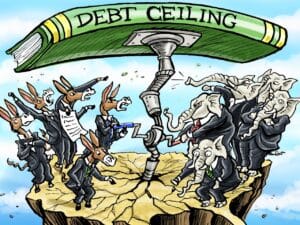
Debt ceiling brinksmanship the ‘Sword of Damocles’ for investors
Mickey Kim and Roger Lee / May 19, 2023

In an ancient moral parable, the Roman philosopher Cicero told the tale of Dionysius II, a tyrannical king, and his court jester Damocles who commented on the blissful, carefree life he imagined his king lived. Perturbed, Dionysius let Damocles indulge in the fruits of his crown, which Damocles thoroughly enjoyed until he observed a razor-sharp sword suspended by a single thread hanging directly over his head. Damocles quickly decided he preferred the life of a jester and the phrase “Sword of Damocles” now describes any looming danger.
With the U.S. government having reached its current congressionally mandated $31.4 trillion borrowing limit (“debt ceiling”) on January 19 and Treasury Secretary Janet Yellen recently announcing Treasury’s trick bag of “extraordinary measures” will be empty by June 1 (the “X-Date,” after which the government can no longer pay its obligations in full and on time), investors once again find themselves staring up at the proverbial sword.
To gain a better understanding of the debt ceiling, think of the federal government as your spendthrift friend who, despite best intentions, consistently spends more than he earns. To cover the government’s resulting deficit, the Treasury borrows money by issuing new government securities, which promise to pay the lender/purchaser periodic interest and return the principal at maturity, which can range from 3-months to 30-years. The new securities are added to the total amount of federal debt outstanding. Since 1917, Congress has set the maximum amount of federal debt allowed, known as the “debt ceiling.”
It seems illogical the debt ceiling and level of government spending operate independently of one another. When lawmakers authorize new spending, the ceiling isn’t automatically increased. Similarly, raising the debt limit doesn’t authorize new spending; it only allows the Treasury to issue new debt to cover spending Congress has already authorized. Once the debt ceiling has been reached, new debt cannot be issued until Congress votes to raise or suspend the limit. Since 1960, Congress has increased the ceiling seventy-eight times, most recently in December 2021 (by $2.5 trillion—gone in 13 months). Forty-nine occurred during Republican administrations and twenty-nine when a Democrat was in the White House. Additionally, Congress has suspended the debt limit seven times since 2013.
The Economist describes the debt ceiling as a “political creation devoid of any fundamental economic meaning.” Thus, we are periodically and needlessly subjected to having the debt ceiling “weaponized.” During the Trump administration, the debt ceiling was increased “clean” (without preconditions) three times as the national debt rose by $8 trillion. This time, President Biden would also like a “clean” debt limit increase. House Republicans voted to approve raising the debt ceiling by $1.5 trillion, but only if already approved government spending is cut by $4.8 trillion over the next ten years.
Both Biden’s and House Speaker McCarthy’s positions appear intractable and the high stakes game of “chicken” becomes more dangerous the closer the clock ticks towards midnight. We’ve stared into the abyss before. In 2011 congressional Republicans refused to raise the debt limit unless President Obama agreed to defund the already approved Affordable Care Act (Obamacare). An 11th hour deal was reached a scant two days before the X-Date, but the brinksmanship triggered the most volatile week for U.S. stocks since the Global Financial Crisis and the credit rating agency S&P Global Ratings downgraded the creditworthiness of the U.S. for the first time ever.
If the debt limit is not increased, dire consequences will follow for people all over the world. The sudden cessation of Social Security/Medicare payments and government salaries/spending would impact recipients and likely cause a deep recession at home. Global financial markets rely heavily on the relative economic and political stability of the United States. Contrary to Damocles’ experience, it is good to be king. Having the world’s “reserve” currency allows us to borrow and buy cheaper and there are many who would love to take our place, friend and foe alike.
The U.S. defaulting and not honoring its debts would crush demand for U.S. Treasury securities, sending yields soaring and the dollar plunging as they would never again be considered perfectly safe. This would be uncharted territory and could trigger another global financial crisis.
Let’s hope it doesn’t get to that point.
This is not to say our levels of debt and spending are fine. They’re not. Hard to believe, but during the Clinton administration, the U.S. actually had three consecutive budget surpluses: $69 billion in 1998, $126 billion in 1999 and $236 billion in 2000. When Clinton left office in January 2001, our national debt stood at $5.7 trillion. Interest rates were extraordinarily low during the period our level of debt exploded, which eased the burden of servicing the debt. With rates materially higher, the pain will be intense.
The old playbook of “extend and pretend” needs to be thrown out, but the best solutions are seldom discovered under extreme duress. Mitch “The Blade” Daniels (former Indiana governor, Purdue University president and Office of Management and Budget director under George W. Bush) is Co-Chair of the bipartisan Committee for a Responsible Federal Budget. In a recent excellent report, the Committee said, “To be sure, political advantage should not be sought by threatening default and the debt ceiling must be raised or suspended. Lawmakers must not jeopardize the full faith and credit of the U.S. government. At the same time, the need to raise the debt ceiling can serve as a useful moment for taking stock of our fiscal state and for pursuing revenue increases, entitlement reform and/or spending reductions.”
The opinions expressed in these articles are those of the author as of the date the article was published. These opinions have not been updated or supplemented and may not reflect the author’s views today. The information provided in these articles are not intended to be a forecast of future events, a guarantee of future results and do not provide information reasonably sufficient upon which to base an investment decision and should not be considered a recommendation to purchase or sell any particular stock or other investment.









